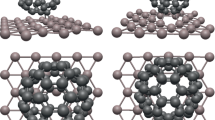Abstract
An analytical model of the interaction between Al and C atoms at the interfaces formed by carbon nanoparticles and aluminum is proposed. The model is convenient for practical use in calculating the free energy of the interface, which is essential for nanocomposites and determines their mechanical, thermophysical, and other properties. The paper considers nanoparticles of various structures that are used in the development of aluminum matrix composites: fullerenes of various diameters, single-layer carbon nanotubes of metal and semiconductor types of various radii and chirality, graphene, and graphite. The proposed model employs the Lennard–Jones potential and approximately takes into account the effect of the local structure of the nanoparticle on the interaction of pairs of aluminum and carbon atoms using additional parameters. In this paper, we assume that the average local curvature of the nanoparticle surface determines the depth and location of the potential well. The work is supplemented with the study of interphase interaction in the framework of the density functional theory. The comparison of the results of calculations performed using approximations of various levels of accuracy is used to establish the limits of applicability of the proposed potential, and the possibility of its application in the study of interfacial interaction in nanocomposites based on aluminum and nanocarbon is shown.



Similar content being viewed by others
REFERENCES
P. Sharma, S. Ganti, and N. Bhate, Appl. Phys. Lett. 82 (4), 535 (2003).
V. Reshetniak et al., Nanomaterials 12 (12), 2045 (2022).
M. E. Gurtin, J. Weissmüller, and F. Larche, Philos. Mag. A 78 (5), 1093 (1998).
I. G. Kaplan, Intermolecular Interactions: Physical Picture, Computational Methods and Model Potentials (Wiley, 2006).
T. Liang et al., Mater. Sci. Eng., R 74 (9), 255 (2013).
S. Nasiri et al., Materialia 22, 101376 (2022).
V. V. Reshetniak and A. V. Aborkin, J. Exp. Theor. Phys. 130 (2), 214 (2020).
V. V. Reshetnyak et al., J. Exp. Theor. Phys. 134 (1), 69 (2022).
M. S. Dresselhaus, G. Dresselhaus, and P. C. Eklund, Science of Fullerenes and Carbon Nanotubes: Their Properties and Applications (Elsevier, 1996).
I. A. Evdokimov et al., Konstr. Kompoz. Mater., No. 1, 43 (2013).
A. H. Larsen et al., J. Phys.: Condens. Matter 29 (27), 273002 (2017).
T. D. Kühne et al., J. Chem. Phys. 152 (19), 194103 (2020). https://doi.org/10.1063/5.0007045
J. P. Perdew, K. Burke, and M. Ernzerhof, Phys. Rev. Lett. 77 (18), 3865 (1996).
M. F. Peintinger, D. V. Oliveira, and T. Bredow, J. Comput. Chem. 34 (6), 451 (2013).
S. Plimpton, J. Comput. Phys. 117 (1), 1 (1995).
E. A. Belenkov and V. A. Greshnyakov, Phys. Solid State 55, 1754 (2013).
R. C. Haddon, Philos. Trans. R. Soc. London, Ser. A 343 (1667), 53 (1993).
D. Holec et al., Phys. Rev. B 81 (23), 235403 (2010).
G. Casella, A. Bagno, and G. Saielli, Phys. Chem. Chem. Phys. 15 (41), 18030 (2013).
M. Shiraishi and M. Ata, Carbon 39 (12), 1913 (2001).
Funding
This work was supported by the Ministry of Science and Higher Education of the Russian Federation (project FZUN-2020-0015).
Author information
Authors and Affiliations
Corresponding authors
Ethics declarations
The authors of this work declare that they have no conflicts of interest.
Additional information
Translated by A. Chikishev
Publisher’s Note.
Pleiades Publishing remains neutral with regard to jurisdictional claims in published maps and institutional affiliations.
Rights and permissions
About this article
Cite this article
Reshetniak, V.V., Aborkin, A. Interaction of Al–C Atoms at the Aluminum–Carbon Nanoparticle Interface. Tech. Phys. (2024). https://doi.org/10.1134/S106378422470021X
Received:
Revised:
Accepted:
Published:
DOI: https://doi.org/10.1134/S106378422470021X




